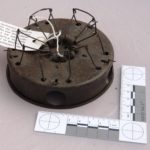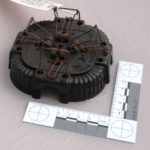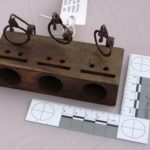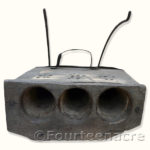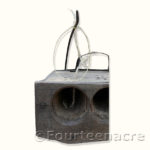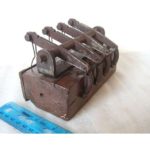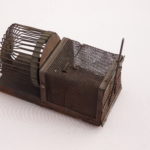Description
Choker Mouse traps are a very common style of mouse trap, used particularly in Europe and the USA and although many different types exist, the principle of the trap remains the same. The body of the trap includes a number of holes, which act as tunnels and are baited at the far end. A spring powered noose is able to move up and down just inside the mouth of the hole, usually fed through a slot cut through the top of the trap. When the spring is at rest this noose is held high so that any mouse caught in it is jerked up against the top of the tunnel and killed. mouse.
In order to hold the sprung loop in place and release it when a mouse enters two types of trigger mechanism have developed. The traditional approach is a simple one. A piece of string is inserted through two pairs of corresponding holes, one pair at the top and the other in the base. The string is passed over the spring and tied tight – holding the spring down and the noose in place. The twin strands of the string pass through the tunnel top to bottom, effectively blocking it but allowing sight and smell of the bait. To reach the bait a mouse must chew through the string – which releases the spring and so lifts the noose.
More recent examples such at the Hotchkiss and the Victor have a more sophisticated and reusable trigger. The noose is held in place by a small pivoted lever which extends down into the tunnel. The action of the mouse pushing against this slips the hold and releases the noose.
The following galleries give some examples and there are several Choker traps for sale in our Vintage trap shop.
Commercial Examples
- The Hotchkiss mouse trap was first patented in America on 28th December 1886, patent No. 355016 by Edward Hotchkiss. A further patent, No.449534 was taken out by Hotchkiss in 1891. There are 5 holes each equipped with double coil springs, choker loop and trigger mechanism. The 4½” pressed steel body is stamped with the name HOTCHKISS. Believed to have been made by Oneida Community Ltd, Canada.
- This is a ‘Victor 4-hole Choker Mouse Trap’ made by Woodstream Corporation, Lititz, Pennsylvania, USA. The double-coil spings, loops and trigger assemblies are mounted on a moulded plastic base. This was a development of the ‘thread set’ chokers that had been used for centuries earlier. In this trap the springs are held down by pivoting wire triggers. This example dates from about 1990.
- The ‘Lucifer’ Souriciere (choker mouse trap) is a classic choker trap which consists of a series of deep holes forming tunnels which are baited at the far end, in this case 3 of them. Across the front of each tunnel there is a slot, just inside the mouth of the hole, which takes a noose ring inserted from above. This noose is attached to a spring which will jerk the noose upwards when triggered, capturing and killing the mouse.
- An early and exceptional example of the ‘Improved Irish’ trap, in perfect working order with original parts. The fruitwood block is intact and solid, with no wormholes. It measures 5 1/2 x 2 1/2 x 1 1/2 inches. When the bait hooks within the holes are moved by the mouse it triggers the loop to garotte from below.
Handmade French block trap
- This is a French home made or artisan trap which we know is at least 30 years old, but probably older. We know a little bit about this trap because when we were cleaning it we found newspaper stuffed inside the end of the tunnels. Luckily is was a page of adverts which identified the paper as from Besancon, a town in eastern France, not far from the Swiss and German borders.
- It is a classic choker trap which consists of a series of deep holes forming tunnels which are baited at the far end, in this case 3 of them. Across the front of each tunnel there is a slot, just inside the mouth of the hole, which takes a noose inserted from above.
- This noose is attached to a spring which will jerk the noose upwards when triggered, capturing and killing the mouse. The trigger mechanism is a simple one. A piece of string is inserted through two pairs of corresponding holes, one pair at the top and the other in the base. The string is passed over the spring and tied tight – holding the spring down and the noose in place. The twin strands of the string pass through the tunnel top to bottom, effectively blocking it but allowing sight and smell of the bait.
- To reach the bait a mouse must chew through the string – which releases the spring and so lifts the noose.
Heavy Duty Spring & Loops
- This choker mouse trap appeared on ebay in September 2012 and sold for £51. The images and listing details are reproduced here with permission of the seller.
- It is a four hole solid wooden mouse trap working condition with heavy metal fittings base measures approx 6 1/2″ long x 3 1/4″ overall the trap is 3 3/4″ high, wood work is solid aged in parts and treated with preservative.
- The twin holes on each choker suggest that this was a ‘string set’ trigger, where the mouse would chew through a string to get at the bait and in doing so release the trap.

